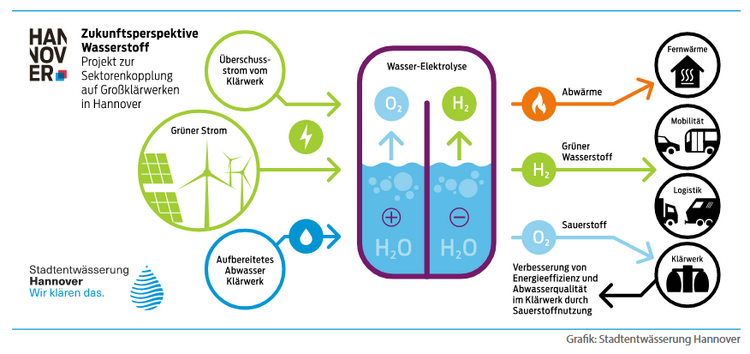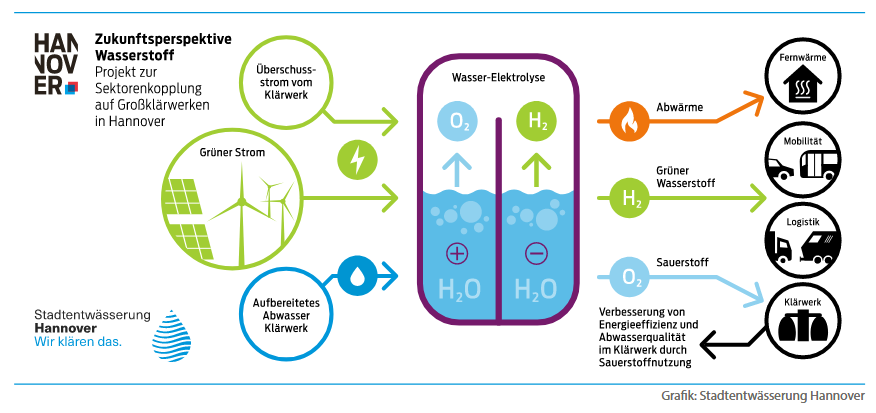SeWAGE PLANT H -SeWAGE PLANT H - Sector-coupled production of hydrogen, oxygen and waste heat at the large-scale waste water treatment plant in Hannover-Herrenhausen, Germany

| Led by: | Dr.-Ing. Maike Beier, PD Dr.-Ing. habil. Dirk Weichgrebe |
| E-Mail: | beier@isah.uni-hannover.de, weichgrebe@isah.uni-hannover.de |
| Team: | Sara Zahedi Nezhad, Arne Freyschmidt |
| Year: | 2025 |
| Funding: | Land Niedersachsen (niedersächsische Wasserstoffförderrichtlinie) |
| Duration: | 09/2021 - 12/2025 |
Since renewable energies stemming from sun and wind are not instantly available in sufficient quantities to meet the current demand, energy storage plays a key role in transitioning from a fossil fuel based economy into a sustainable, CO2-eq-neutral economic system. In this context, hydrogen is considered one of the essential energy carriers of the future, since hydrogen can be produced with surplus energy by the electrochemical process of electrolysis from fully desalinated water. Subsequently, the hydrogen produced can be converted into energy whenever required. The use of hydrogen is of importance not only in mobility (fuel cell), but also in industry in particular; in many industrial sectors, the use of hydrogen for defossilization is without alternative.
Pure oxygen is produced as a by-product of hydrogen generation by means of water electrolysis. In wastewater treatment, oxygen is essential for aerobic biological processes to take place. At present, biological reactors at wastewater treatment plants are aerated with compressed air (O2 content approx. 21 %) at high energy cost. The blowers required for this purpose are among the main energy consumers in wastewater treatment. The use of pure oxygen could considerably reduce the volume of gas introduced and thus significantly lower the energy requirements of a wastewater treatment plant. For this reason, hydrogen production at wastewater treatment plants is an attractive option, as the by-product pure oxygen can be used directly and conventional aeration can be at least partially replaced.
Within the framework of the SeWAGE PLANT H research project, an electrolyzer for hydrogen production (1st stage: 2.5 MW; 2nd stage: 17 MW) is therefore being built at the Hannover-Herrenhausen wastewater treatment plant with the aim of contributing to actual sector coupling by using all material flows. While the hydrogen produced is used locally as an energy carrier (e.g. in local public transport), the oxygen is used directly at the sewage treatment plant to support the biological stage. The waste heat from the electrolyzer is fed into the local district heating network. By using process water streams in the electrolysis, it is also possible to conserve valuable drinking water supplies and contribute to water recycling.



The Institute of Sanitary Engineering and Waste Management (ISAH), together with the Institute for Electrical Energy Systems (IfES), is responsible for the scientific support of the research project. The following focal points are being worked on:
Research focus on pure oxygen utilization
The main focus of the work on the use of pure oxygen is concerned with various approaches to the use of the pure oxygen produced in the Hannover-Herrenhausen/Hannover-Gümmerwald wastewater treatment plants. The investigations to be carried out are divided into three work packages:
- Work package system integration existing system
- Work package system integration high load stage
- Work package system integration ozonation
The work package "System integration existing system" investigates how pure oxygen can be used in the main stream (activated sludge) of the Hannover-Herrenhausen wastewater treatment plant. One research focus is on the collection of data for the model-based description of the mechanics of pure oxygen transfer into the wastewater; this issue is being addressed in cooperation with the IWAR Institute of the Technical University of Darmstadt. The results of these investigations will then be incorporated into the development of operating concepts for pure oxygen utilization as a function of the daily, weekly and annually fluctuating oxygen demand of the biological stage and the possible pure oxygen supply by the electrolyzer. In particular, it must be clarified which degree of coverage of the oxygen demand can be achieved, when pure oxygen is generated/added, whether storage of the pure oxygen is necessary/useful, and what a possible aeration strategy might look like. The developed concepts will be model tested and optimized.
The "System integration high-load stage" work package comprises investigations into the use of pure oxygen in a separate high-load treatment stage for nitrogen-containing process waters produced during sludge treatment. For this purpose, a pilot-scale plant (deammonification) is operated. From the plant operation, parameters for nitrogen elimination with pure oxygen will be derived and possible operating concepts/ control strategies will be developed. Emission of the greenhouse gas dinitrogen monoxide (N2O) formed during nitritation will be emphasized; this is directly dependent on the introduced gas volume flow (stripping). If the N2O formed can be kept in the water phase, it can be converted to gaseous nitrogen by heterotrophic denitrifiers. The pilot plant operation is also accompanied by modeling in order to determine the effects of the startup of a deammonification stage on the main stream and to develop optimized operating strategies and control concepts for the industrial scale.
In the work package "System integration ozonation", a concept for the use of the produced pure oxygen for ozone generation will be developed based on theoretical data. The background is a potential use of the purified wastewater for irrigation of the Herrenhäuser Gardens. For this purpose, high requirements regarding the contamination of the purified wastewater with pathogens have to be met.
Finally, on the basis of the results obtained, a final concept for the use of pure oxygen will be defined in close cooperation with the partners in the project and, in particular, with Stadtentwässerung Hannover as the operator of the Hannover-Herrenhausen and Hannover-Gümmerwald wastewater treatment plants. The focus is on a holistic approach. The selected utilization concept will be implemented in large-scale in the second project phase.
Research focus on system analysis of sector coupling in the context of wastewater treatment plants
In the work package "System analysis for sector coupling in the context of wastewater treatment plants", IfES and ISAH are jointly working on the development of a toolbox for the design of P2X systems at wastewater treatment plants. The aim of the toolbox is to optimise the design, dimensioning and operational management of P2X systems in the context of sector coupling, taking into account energy, economic and ecological criteria. For this purpose, relevant components of water electrolysis plants, upstream and downstream processes as well as the interfaces and processes for sector coupling (mobility and district heating) are modelled. In addition, the interfaces and relevant processes and components of the wastewater treatment plant are modelled. Furthermore, suitable circuit variants and operation management concepts for P2X systems at wastewater treatment plants are identified and modelled. ISAH evaluates the ecological impacts of the concepts developed by IfES by developing ecological models. The corresponding ecological models will be integrated into the toolbox and thus enable an integrated ecological assessment in the optimisation of the overall system. The developed toolbox is intended to serve as a "blueprint" to enable the transfer of such concepts to other wastewater treatment plants in Germany and possibly beyond in the future.
The ecological assessment models are developed according to DIN EN ISO 14040 and DIN EN ISO 14044. The main objectives of the ecological assessment are:
- Determination of direct and indirect emissions resulting from the use of pure oxygen for biological wastewater treatment and ozonation.
- Identification of the ecological consequences of integrating the water electrolysis plant into the wastewater treatment plant.
In order to forecast the ecological advantages and disadvantages and to support critical decision-making, taking into account the ecological consequences, a comparison is made between the status quo and the results of the model calculations. Thus, a "decision support system" with model character is developed.